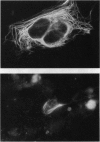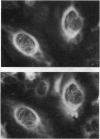Abstract
Ataxia-telangiectasia (AT) is an autosomal recessive human genetic disease characterized by immunological, neurological, and developmental defects and an increased risk of cancer. Cells from individuals with AT show sensitivity to ionizing radiation, elevated recombination, cell cycle abnormalities, and aberrant cytoskeletal organization. The molecular basis of the defect is unknown. A candidate AT gene (ATDC) was isolated on the basis of its ability to complement the ionizing radiation sensitivity of AT group D fibroblasts. Whether ATDC is mutated in any AT patients is not known. We have found that the ATDC protein physically interacts with the intermediate-filament protein vimentin, which is a protein kinase C substrate and colocalizing protein, and with an inhibitor of protein kinase C, hPKCI-1. Indirect immunofluorescence analysis of cultured cells transfected with a plasmid encoding an epitope-tagged ATDC protein localizes the protein to vimentin filaments. We suggest that the ATDC and hPKCI-1 proteins may be components of a signal transduction pathway that is induced by ionizing radiation and mediated by protein kinase C.
Full text
PDF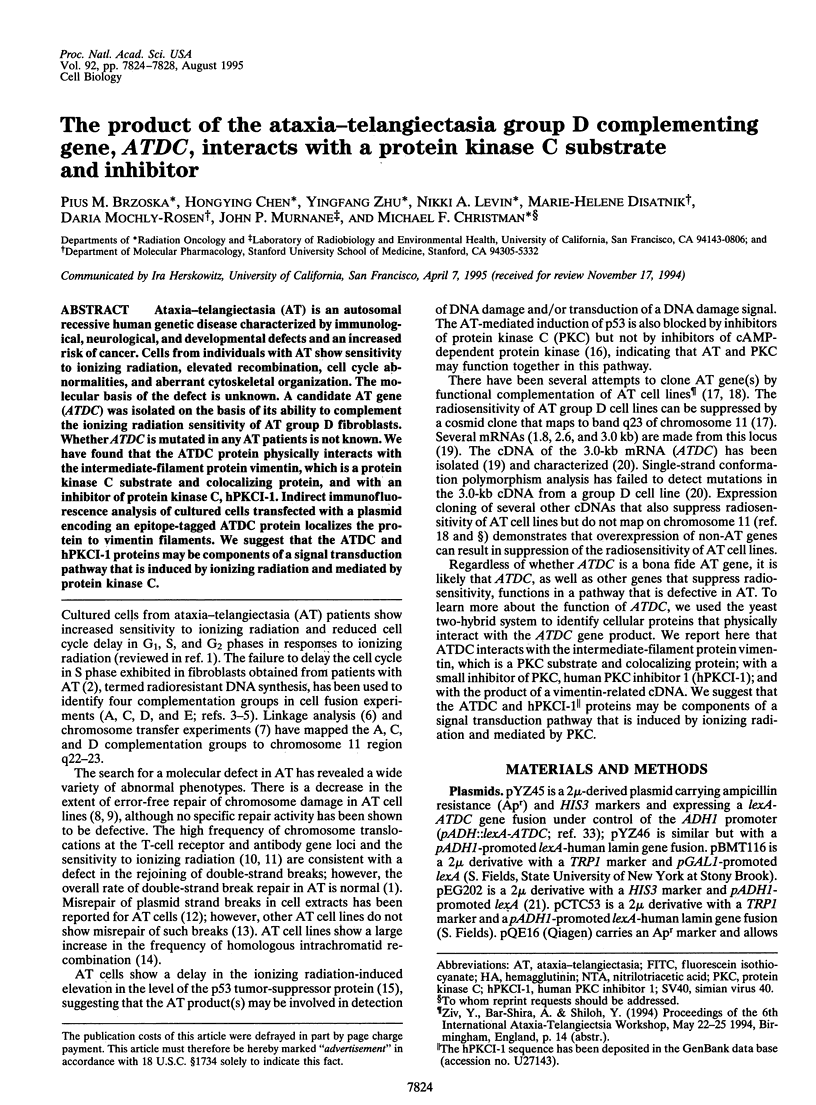
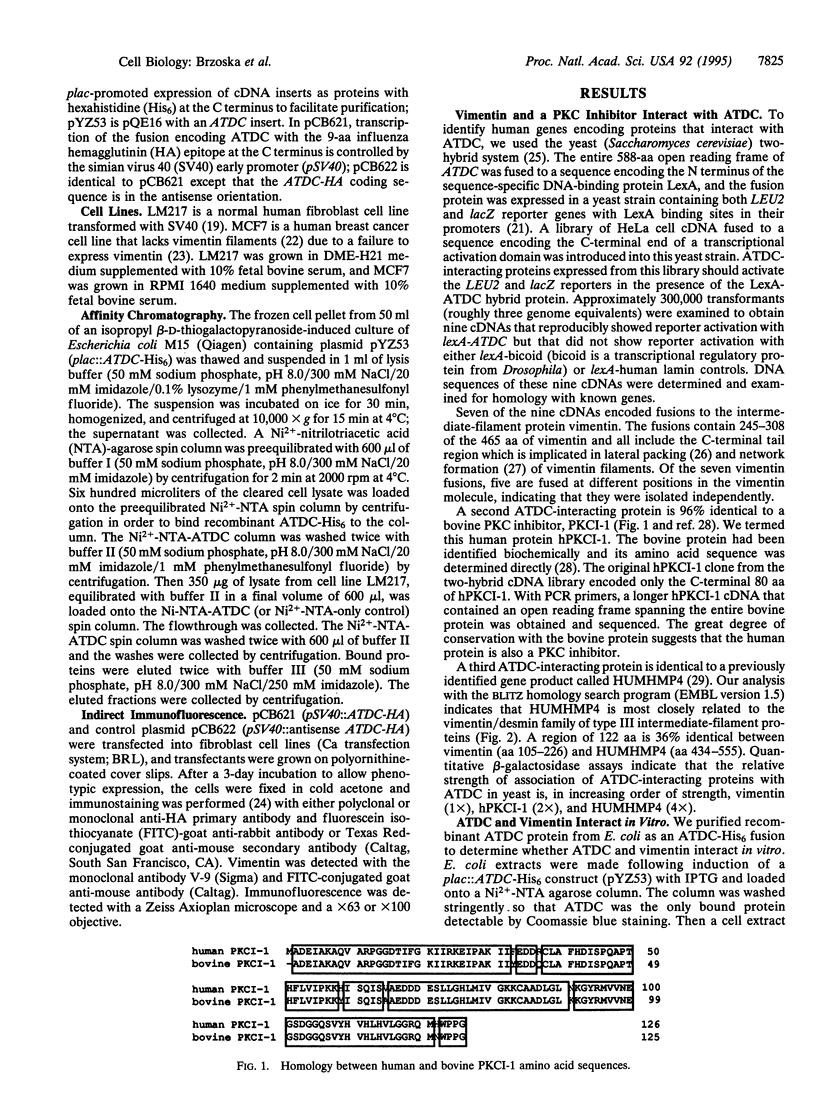
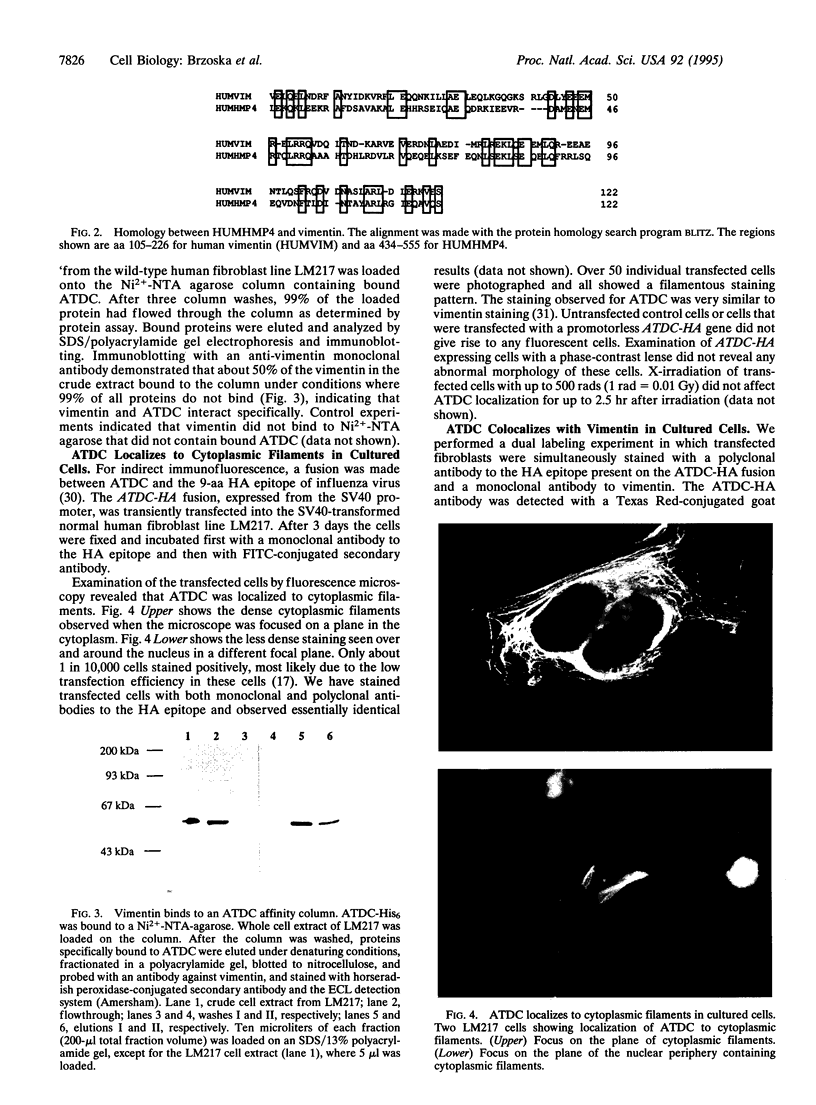
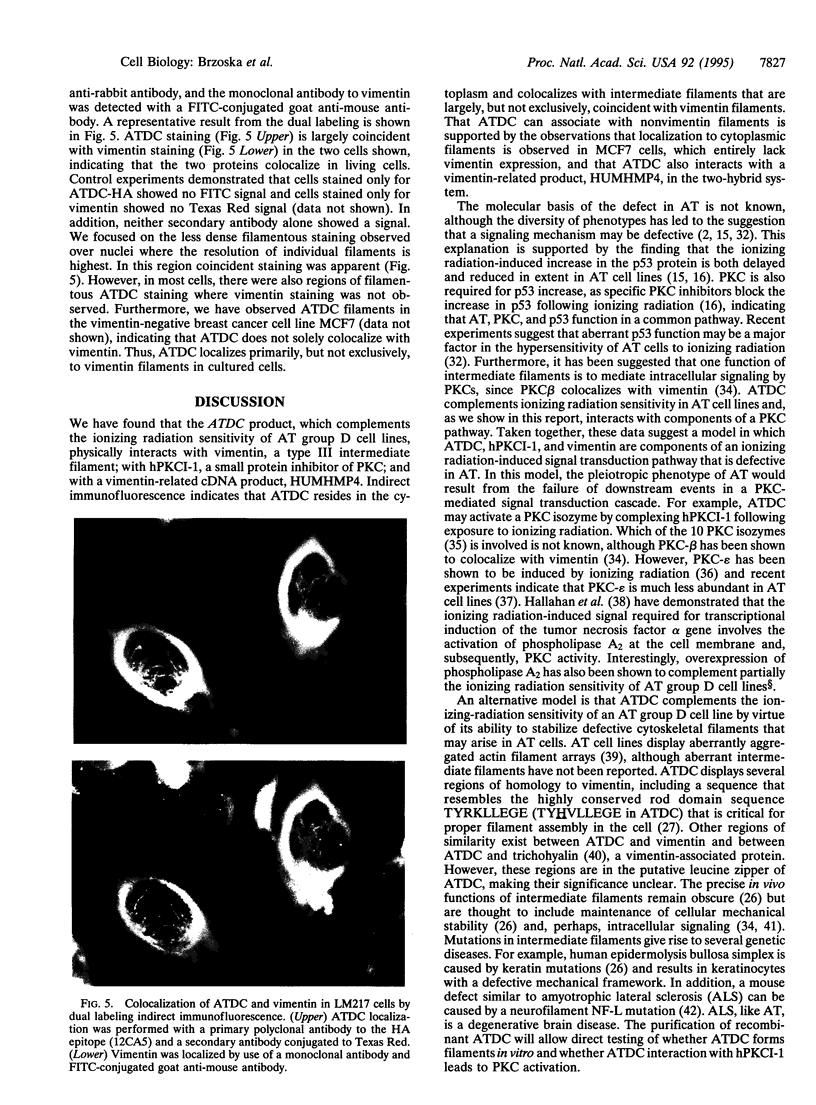
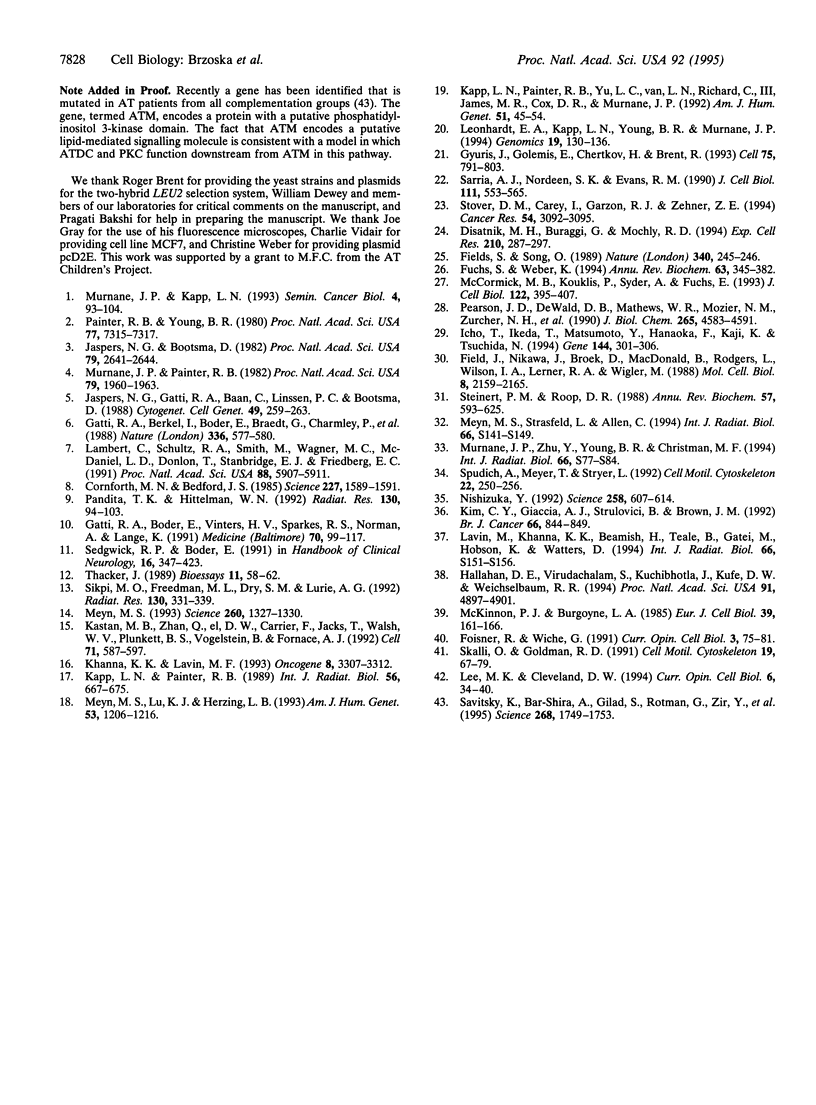
Images in this article
Selected References
These references are in PubMed. This may not be the complete list of references from this article.
- Cornforth M. N., Bedford J. S. On the nature of a defect in cells from individuals with ataxia-telangiectasia. Science. 1985 Mar 29;227(4694):1589–1591. doi: 10.1126/science.3975628. [DOI] [PubMed] [Google Scholar]
- Disatnik M. H., Buraggi G., Mochly-Rosen D. Localization of protein kinase C isozymes in cardiac myocytes. Exp Cell Res. 1994 Feb;210(2):287–297. doi: 10.1006/excr.1994.1041. [DOI] [PubMed] [Google Scholar]
- Field J., Nikawa J., Broek D., MacDonald B., Rodgers L., Wilson I. A., Lerner R. A., Wigler M. Purification of a RAS-responsive adenylyl cyclase complex from Saccharomyces cerevisiae by use of an epitope addition method. Mol Cell Biol. 1988 May;8(5):2159–2165. doi: 10.1128/mcb.8.5.2159. [DOI] [PMC free article] [PubMed] [Google Scholar]
- Fields S., Song O. A novel genetic system to detect protein-protein interactions. Nature. 1989 Jul 20;340(6230):245–246. doi: 10.1038/340245a0. [DOI] [PubMed] [Google Scholar]
- Foisner R., Wiche G. Intermediate filament-associated proteins. Curr Opin Cell Biol. 1991 Feb;3(1):75–81. doi: 10.1016/0955-0674(91)90168-x. [DOI] [PubMed] [Google Scholar]
- Fuchs E., Weber K. Intermediate filaments: structure, dynamics, function, and disease. Annu Rev Biochem. 1994;63:345–382. doi: 10.1146/annurev.bi.63.070194.002021. [DOI] [PubMed] [Google Scholar]
- Gatti R. A., Berkel I., Boder E., Braedt G., Charmley P., Concannon P., Ersoy F., Foroud T., Jaspers N. G., Lange K. Localization of an ataxia-telangiectasia gene to chromosome 11q22-23. Nature. 1988 Dec 8;336(6199):577–580. doi: 10.1038/336577a0. [DOI] [PubMed] [Google Scholar]
- Gatti R. A., Boder E., Vinters H. V., Sparkes R. S., Norman A., Lange K. Ataxia-telangiectasia: an interdisciplinary approach to pathogenesis. Medicine (Baltimore) 1991 Mar;70(2):99–117. [PubMed] [Google Scholar]
- Gyuris J., Golemis E., Chertkov H., Brent R. Cdi1, a human G1 and S phase protein phosphatase that associates with Cdk2. Cell. 1993 Nov 19;75(4):791–803. doi: 10.1016/0092-8674(93)90498-f. [DOI] [PubMed] [Google Scholar]
- Hallahan D. E., Virudachalam S., Kuchibhotla J., Kufe D. W., Weichselbaum R. R. Membrane-derived second messenger regulates x-ray-mediated tumor necrosis factor alpha gene induction. Proc Natl Acad Sci U S A. 1994 May 24;91(11):4897–4901. doi: 10.1073/pnas.91.11.4897. [DOI] [PMC free article] [PubMed] [Google Scholar]
- Icho T., Ikeda T., Matsumoto Y., Hanaoka F., Kaji K., Tsuchida N. A novel human gene that is preferentially transcribed in heart muscle. Gene. 1994 Jul 8;144(2):301–306. doi: 10.1016/0378-1119(94)90394-8. [DOI] [PubMed] [Google Scholar]
- Jaspers N. G., Bootsma D. Genetic heterogeneity in ataxia-telangiectasia studied by cell fusion. Proc Natl Acad Sci U S A. 1982 Apr;79(8):2641–2644. doi: 10.1073/pnas.79.8.2641. [DOI] [PMC free article] [PubMed] [Google Scholar]
- Jaspers N. G., Gatti R. A., Baan C., Linssen P. C., Bootsma D. Genetic complementation analysis of ataxia telangiectasia and Nijmegen breakage syndrome: a survey of 50 patients. Cytogenet Cell Genet. 1988;49(4):259–263. doi: 10.1159/000132673. [DOI] [PubMed] [Google Scholar]
- Kapp L. N., Painter R. B. Stable radioresistance in ataxia-telangiectasia cells containing DNA from normal human cells. Int J Radiat Biol. 1989 Nov;56(5):667–675. doi: 10.1080/09553008914551891. [DOI] [PubMed] [Google Scholar]
- Kapp L. N., Painter R. B., Yu L. C., van Loon N., Richard C. W., 3rd, James M. R., Cox D. R., Murnane J. P. Cloning of a candidate gene for ataxia-telangiectasia group D. Am J Hum Genet. 1992 Jul;51(1):45–54. [PMC free article] [PubMed] [Google Scholar]
- Kastan M. B., Zhan Q., el-Deiry W. S., Carrier F., Jacks T., Walsh W. V., Plunkett B. S., Vogelstein B., Fornace A. J., Jr A mammalian cell cycle checkpoint pathway utilizing p53 and GADD45 is defective in ataxia-telangiectasia. Cell. 1992 Nov 13;71(4):587–597. doi: 10.1016/0092-8674(92)90593-2. [DOI] [PubMed] [Google Scholar]
- Khanna K. K., Lavin M. F. Ionizing radiation and UV induction of p53 protein by different pathways in ataxia-telangiectasia cells. Oncogene. 1993 Dec;8(12):3307–3312. [PubMed] [Google Scholar]
- Kim C. Y., Giaccia A. J., Strulovici B., Brown J. M. Differential expression of protein kinase C epsilon protein in lung cancer cell lines by ionising radiation. Br J Cancer. 1992 Nov;66(5):844–849. doi: 10.1038/bjc.1992.371. [DOI] [PMC free article] [PubMed] [Google Scholar]
- Lambert C., Schultz R. A., Smith M., Wagner-McPherson C., McDaniel L. D., Donlon T., Stanbridge E. J., Friedberg E. C. Functional complementation of ataxia-telangiectasia group D (AT-D) cells by microcell-mediated chromosome transfer and mapping of the AT-D locus to the region 11q22-23. Proc Natl Acad Sci U S A. 1991 Jul 1;88(13):5907–5911. doi: 10.1073/pnas.88.13.5907. [DOI] [PMC free article] [PubMed] [Google Scholar]
- Lavin M. F., Khanna K. K., Beamish H., Teale B., Hobson K., Watters D. Defect in radiation signal transduction in ataxia-telangiectasia. Int J Radiat Biol. 1994 Dec;66(6 Suppl):S151–S156. [PubMed] [Google Scholar]
- Lee M. K., Cleveland D. W. Neurofilament function and dysfunction: involvement in axonal growth and neuronal disease. Curr Opin Cell Biol. 1994 Feb;6(1):34–40. doi: 10.1016/0955-0674(94)90113-9. [DOI] [PubMed] [Google Scholar]
- Leonhardt E. A., Kapp L. N., Young B. R., Murnane J. P. Nucleotide sequence analysis of a candidate gene for ataxia-telangiectasia group D (ATDC). Genomics. 1994 Jan 1;19(1):130–136. doi: 10.1006/geno.1994.1022. [DOI] [PubMed] [Google Scholar]
- McCormick M. B., Kouklis P., Syder A., Fuchs E. The roles of the rod end and the tail in vimentin IF assembly and IF network formation. J Cell Biol. 1993 Jul;122(2):395–407. doi: 10.1083/jcb.122.2.395. [DOI] [PMC free article] [PubMed] [Google Scholar]
- McKinnon P. J., Burgoyne L. A. Altered cellular morphology and microfilament array in ataxia-telangiectasia fibroblasts. Eur J Cell Biol. 1985 Nov;39(1):161–166. [PubMed] [Google Scholar]
- Meyn M. S. High spontaneous intrachromosomal recombination rates in ataxia-telangiectasia. Science. 1993 May 28;260(5112):1327–1330. doi: 10.1126/science.8493577. [DOI] [PubMed] [Google Scholar]
- Meyn M. S., Lu-Kuo J. M., Herzing L. B. Expression cloning of multiple human cDNAs that complement the phenotypic defects of ataxia-telangiectasia group D fibroblasts. Am J Hum Genet. 1993 Dec;53(6):1206–1216. [PMC free article] [PubMed] [Google Scholar]
- Meyn M. S., Strasfeld L., Allen C. Testing the role of p53 in the expression of genetic instability and apoptosis in ataxia-telangiectasia. Int J Radiat Biol. 1994 Dec;66(6 Suppl):S141–S149. [PubMed] [Google Scholar]
- Murnane J. P., Kapp L. N. A critical look at the association of human genetic syndromes with sensitivity to ionizing radiation. Semin Cancer Biol. 1993 Apr;4(2):93–104. [PubMed] [Google Scholar]
- Murnane J. P., Painter R. B. Complementation of the defects of DNA synthesis in irradiated and unirradiated ataxia-telangiectasia cells. Proc Natl Acad Sci U S A. 1982 Mar;79(6):1960–1963. doi: 10.1073/pnas.79.6.1960. [DOI] [PMC free article] [PubMed] [Google Scholar]
- Murnane J. P., Zhu Y., Young B. R., Christman M. F. Expression of the candidate A-T gene ATDC is not detectable in a human cell line with a normal response to ionizing radiation. Int J Radiat Biol. 1994 Dec;66(6 Suppl):S77–S84. [PubMed] [Google Scholar]
- Nishizuka Y. Intracellular signaling by hydrolysis of phospholipids and activation of protein kinase C. Science. 1992 Oct 23;258(5082):607–614. doi: 10.1126/science.1411571. [DOI] [PubMed] [Google Scholar]
- Painter R. B., Young B. R. Radiosensitivity in ataxia-telangiectasia: a new explanation. Proc Natl Acad Sci U S A. 1980 Dec;77(12):7315–7317. doi: 10.1073/pnas.77.12.7315. [DOI] [PMC free article] [PubMed] [Google Scholar]
- Pandita T. K., Hittelman W. N. Initial chromosome damage but not DNA damage is greater in ataxia telangiectasia cells. Radiat Res. 1992 Apr;130(1):94–103. [PubMed] [Google Scholar]
- Pearson J. D., DeWald D. B., Mathews W. R., Mozier N. M., Zürcher-Neely H. A., Heinrikson R. L., Morris M. A., McCubbin W. D., McDonald J. R., Fraser E. D. Amino acid sequence and characterization of a protein inhibitor of protein kinase C. J Biol Chem. 1990 Mar 15;265(8):4583–4591. [PubMed] [Google Scholar]
- Sarria A. J., Nordeen S. K., Evans R. M. Regulated expression of vimentin cDNA in cells in the presence and absence of a preexisting vimentin filament network. J Cell Biol. 1990 Aug;111(2):553–565. doi: 10.1083/jcb.111.2.553. [DOI] [PMC free article] [PubMed] [Google Scholar]
- Savitsky K., Bar-Shira A., Gilad S., Rotman G., Ziv Y., Vanagaite L., Tagle D. A., Smith S., Uziel T., Sfez S. A single ataxia telangiectasia gene with a product similar to PI-3 kinase. Science. 1995 Jun 23;268(5218):1749–1753. doi: 10.1126/science.7792600. [DOI] [PubMed] [Google Scholar]
- Sikpi M. O., Freedman M. L., Dry S. M., Lurie A. G. Mutation spectrum in gamma-irradiated shuttle vector replicated in ataxia-telangiectasia lymphoblasts. Radiat Res. 1992 Jun;130(3):331–339. [PubMed] [Google Scholar]
- Skalli O., Goldman R. D. Recent insights into the assembly, dynamics, and function of intermediate filament networks. Cell Motil Cytoskeleton. 1991;19(2):67–79. doi: 10.1002/cm.970190202. [DOI] [PubMed] [Google Scholar]
- Spudich A., Meyer T., Stryer L. Association of the beta isoform of protein kinase C with vimentin filaments. Cell Motil Cytoskeleton. 1992;22(4):250–256. doi: 10.1002/cm.970220405. [DOI] [PubMed] [Google Scholar]
- Steinert P. M., Roop D. R. Molecular and cellular biology of intermediate filaments. Annu Rev Biochem. 1988;57:593–625. doi: 10.1146/annurev.bi.57.070188.003113. [DOI] [PubMed] [Google Scholar]
- Stover D. M., Carey I., Garzon R. J., Zehner Z. E. A negative regulatory factor is missing in a human metastatic breast cancer cell line. Cancer Res. 1994 Jun 15;54(12):3092–3095. [PubMed] [Google Scholar]
- Thacker J. Inherited sensitivity to X-rays in man. Bioessays. 1989 Aug-Sep;11(2-3):58–62. doi: 10.1002/bies.950110205. [DOI] [PubMed] [Google Scholar]




